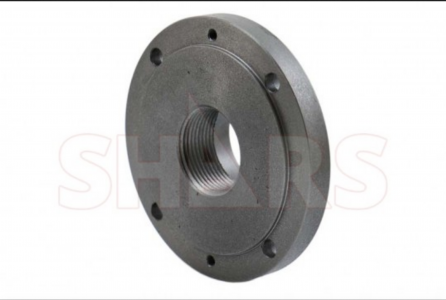-
Welcome back Guest! Did you know you can mentor other members here at H-M? If not, please check out our Relaunch of Hobby Machinist Mentoring Program!
You are using an out of date browser. It may not display this or other websites correctly.
You should upgrade or use an alternative browser.
You should upgrade or use an alternative browser.
Fitting to a backing plate
- Thread starter DavidR8
- Start date
- Joined
- Oct 16, 2019
- Messages
- 6,570
Regarding facing the 'snout' of the backing plate.
This is the backing plate. There is a fairly deep portion that is not threaded. This why I considered facing the snout, to reduce the depth of the unthreaded portion and bring more threads into engagement with the spindle.
I wish I had a photo of it threaded on but I'd bet there's 1/2" of threads that are not engaged.

This is the backing plate. There is a fairly deep portion that is not threaded. This why I considered facing the snout, to reduce the depth of the unthreaded portion and bring more threads into engagement with the spindle.
I wish I had a photo of it threaded on but I'd bet there's 1/2" of threads that are not engaged.

- Joined
- Apr 23, 2018
- Messages
- 6,525
Bob was tapping into some wisdom when he said to trust the manufacturer to have faced it square with the thread bore. That said, you do want full thread engagement for best performance. I personally have done what you proposed earlier, to flip the plate and machine the boss. Flipping the plate does not change the axial relationship of the threads between spindle and plate, that relationship is already set by the manufacturer for you. On my lathe, I need to take a little out of the ID on the boss that protrudes from the back of the plate to fit the step behind the threads on the spindle, and then shorten the boss until the midpoint of the threaded portion of the hole aligns with the midpoint of the threaded portion of the spindle. You will have a square shoulder to butt against and more secure thread engagement of the chuck plate to the spindle for doing so. Just be sure you don't cut it so short that the bolts on the plate (or anything else) interfere with your headstock, so measure thrice and cut once.
On your lathe spindle you should have a register and a face. These work the same way the register and face on the backing plate function. Threads are typically non centering. The backing plate absitively posilutely has to shoulder against the face on the spindle, you can reduce the snout but make sure it bottoms against the face.
A 1040 cold drawn rod threaded 8 TPI will pull about 30 tons before it start to hour glass. Nut didn't fail threads didn't fail the rod reached plastic state and was pulling in two. So you have what about 8-9 threads on a 2 1/8 spindle. Compare that to the shear required for the three mounting bolts on the chuck and see what is stronger. I want to see the video of you taking a big enough cut to rip that chuck off the spindle.
- Joined
- Dec 12, 2016
- Messages
- 493
The next real question should be the fit between the chuck and backplate snout, and there are probably a couple of schools of thought, and I have done it both ways.
For a 4-jaw (independent) chuck, machine to close tolerance fit.
For self centering chucks and collets leave about .005" or so clearance so that you can loosen the mounting bolts and nudge the chuck around for zero runout for a given part.
For a 4-jaw (independent) chuck, machine to close tolerance fit.
For self centering chucks and collets leave about .005" or so clearance so that you can loosen the mounting bolts and nudge the chuck around for zero runout for a given part.
- Joined
- Oct 16, 2019
- Messages
- 6,570

